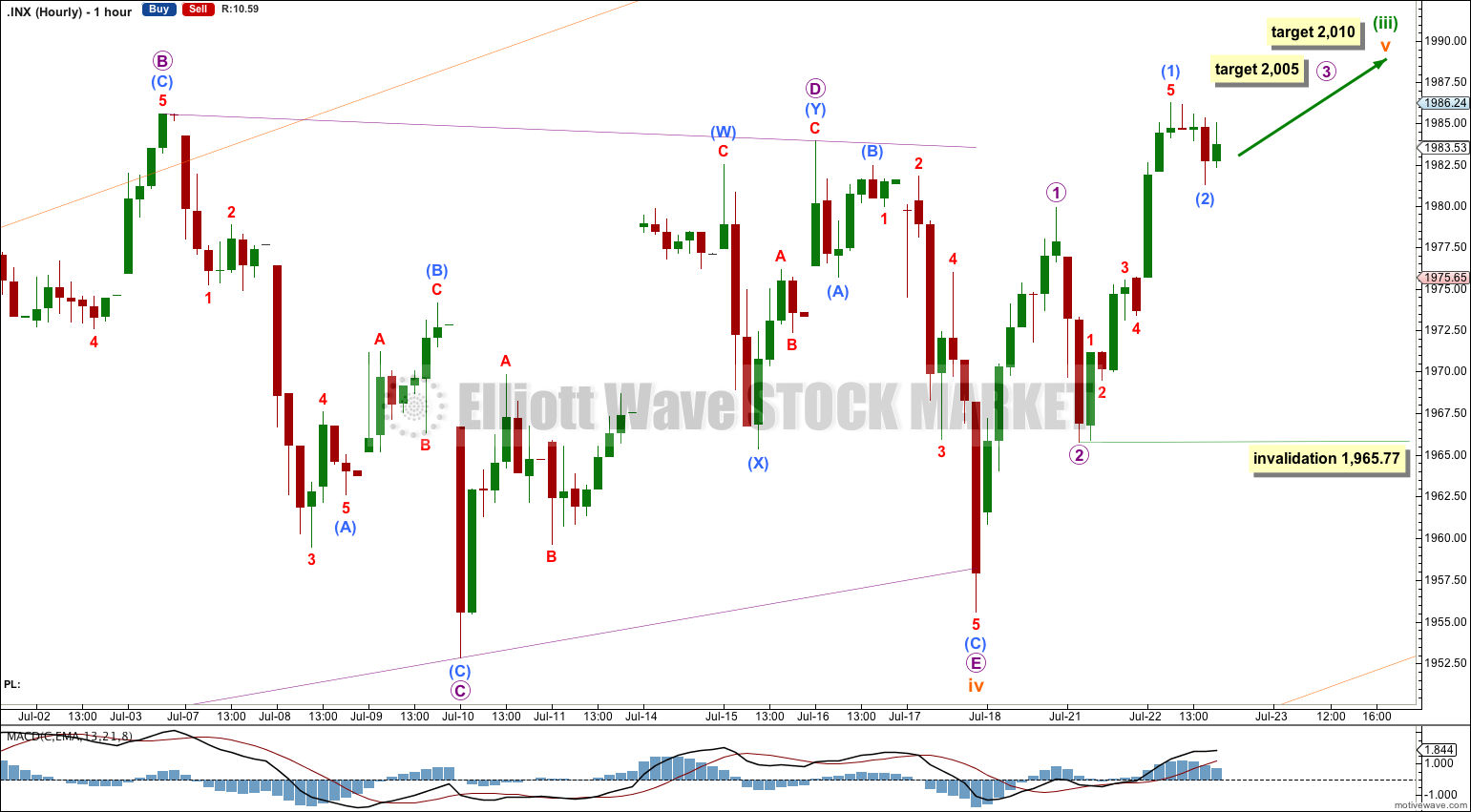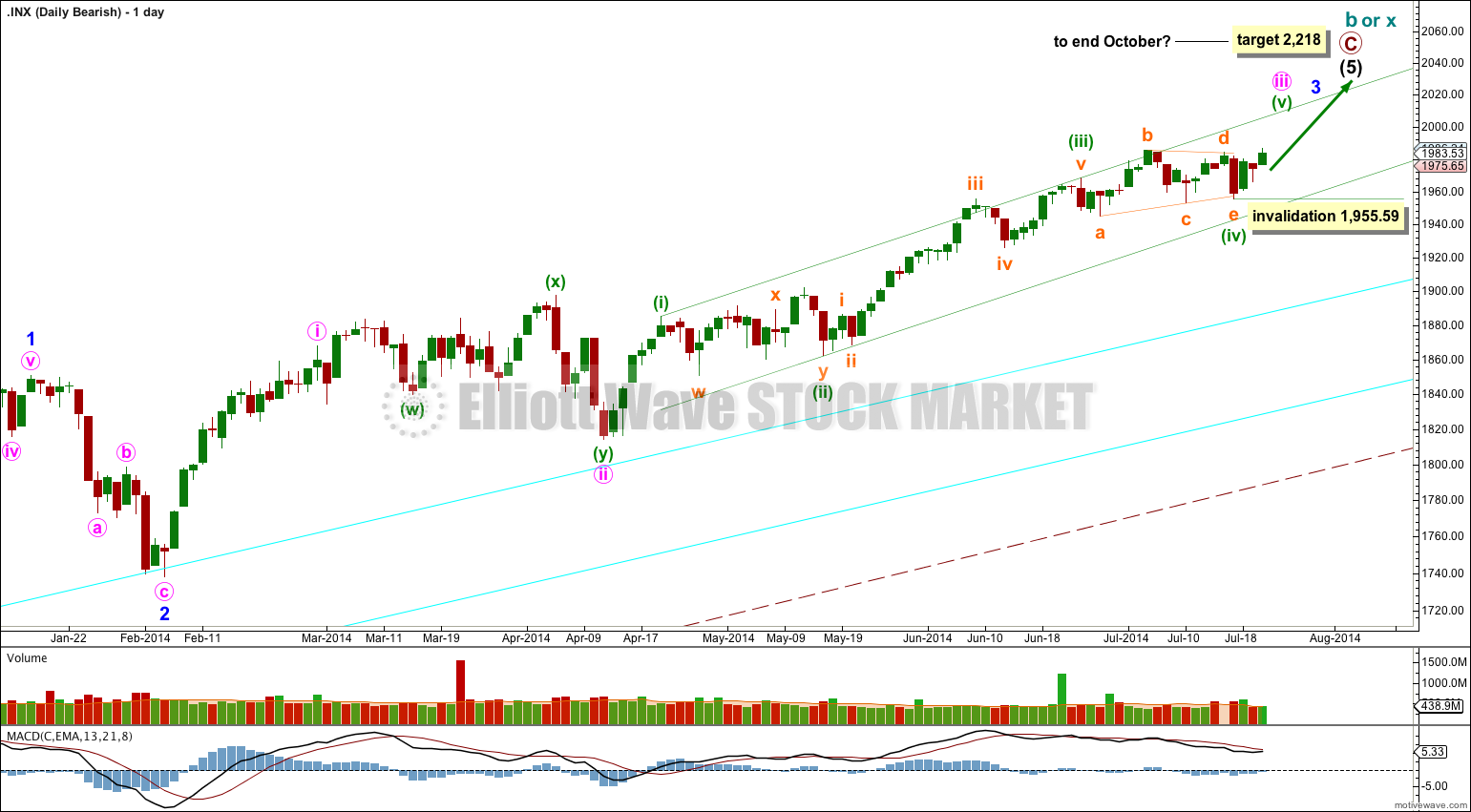Movement above 1,324.73 has confirmed the main Elliott wave hourly wave count and invalidated the alternate.
Summary: The situation is now clear. I expect more upwards movement from here to about 2,010. This target may be met in another one to two weeks.
Click on charts to enlarge.
The aqua blue trend lines are critical. Draw the first trend line from the low of 1,158.66 on 25th November, 2011 to the next swing low at 1,266.74 on 4th June, 2012. Create a parallel copy and place it on the low at 1,560.33 on 24th June, 2013. While price remains above the lower of these two aqua blue trend lines we must assume the trend remains upwards. This is the main reason for the bullish wave count being my main wave count.
Bullish Wave Count.
There are a couple of things about this wave count of which I am confident. I see minor wave 3 within intermediate wave (1) as over at 1,729.86 (19th September, 2013). It has the strongest upwards momentum and is just 0.76 longer than 2.618 the length of minor wave 1. At 455 days duration this is a remarkably close Fibonacci ratio. The subdivisions within it are perfect. If this is correct then minor wave 4 ends at 1,646.47 and this is where minor wave 5 begins.
Minor wave 5 may be only one of two structures: a simple impulse or an ending diagonal. At this stage an ending diagonal looks very unlikely; minor wave 5 is unfolding as an impulse. If minor wave 5 has passed its middle then I would expect to see more divergence between price and MACD develop over coming weeks.
Along the way up towards the final target I would expect to see two more corrections complete: the next for minuette wave (iv) and the last for minute wave iv.
Within subminuette wave v no second wave correction may move beyond its start below 1,955.59.
At 2,010 minuette wave (iii) would reach 1.618 the length of minuette wave (i). Within minuette wave (iii) subminuette wave iii is 8.31 points short of 1.618 the length of subminuette wave i, and so I would not expect to see a Fibonacci ratio for subminuettte wave v. I will leave the target calculation at minuette wave degree.
At 2,218 minor wave 5 would reach equality in length with minor wave 3. This target may be met in October.
I have drawn a parallel channel about minuette wave (iii) using Elliott’s first technique: draw the first trend line from the highs of subminuette waves i to iii, then place a parallel copy on the low of subminuette wave ii. Subminuette wave iv may have remained mostly contained within the channel. Subminuette wave v may end about the upper edge of this channel.
Minuette wave (i) lasted 12 days, just one short of a Fibonacci 13. Minuette wave (ii) lasted a Fibonacci 34 days. Minuette wave (iii) so far has lasted 69 days. The next Fibonacci relationship could see it end in a total 89 days, which now is in 20 days time. However, at this stage I expect that minuette wave (iii) may not exhibit a Fibonacci duration as the target looks like it would be met sooner than four weeks (20 days).
The large maroon – – – channel is copied over from the weekly chart. It is drawn in exactly the same way on bull and bear wave counts. For the bull wave count this channel is termed a base channel about primary waves 1 and 2. A lower degree second wave should not breach the lower edge of a base channel drawn about a first and second wave one or more degrees higher. The lower maroon – – – trend line differentiates the bull and bear wave counts at cycle degree and monthly chart level.
Because the upwards wave labeled submicro wave (1) is shorter than micro wave 1 I expect this is not the end of micro wave 3.
At 2,005 micro wave 3 would reach 1.618 the length of micro wave 1.
Within micro wave 3 submicro wave (1) shows an increase in momentum beyond that seen for micro wave 1. I would expect for this main hourly wave count to see a further increase in upwards momentum as submicro wave (3) unfolds.
Tomorrow when markets open submicro wave (2) could move lower. If it does continue, as a double zigzag, flat or combination, then it may not move beyond the start of submicro wave (1) below 1,965.77.
When micro wave 3 is a complete impulse then micro wave 4 should move sideways, and should show on the daily chart as one or more red candlesticks and / or doji’s.
Alternate Hourly Wave Count
By simply moving the degree of labeling within the last wave up all up one degree this may have been micro wave 3.
Because micro wave 3 is here shorter than micro wave 1, and because a third wave may never be the shortest, this limits micro wave 5 to no longer than equality with micro wave 3 at 2,001.74.
For this alternate idea I would expect micro wave 4 to move a little more sideways so that it shows on the daily chart as a very small red candlestick or a small doji. If it continues it may not move into micro wave 1 price territory below 1,979.91.
This alternate idea has a very low probability while micro wave 4 does not show on the daily chart. It is also less likely that a third wave will be shorter than a first wave; a third wave is most often the longest actionary wave within an impulse. At this stage I would judge this alternate to have about a 10% probability.
Bearish Alternate Wave Count
This bearish alternate wave count expects that the correction is not over. The flat correction which ended at 666.79 was only cycle wave a (or w) of a larger super cycle second wave correction.
The structure and subdivisions within primary wave C for the bear wave count are the same as for intermediate wave (1) for the bull wave count. Thus the short to mid term outlook is identical.
The differentiation between the bull and bear wave count is the maroon – – – channel. The bull wave count should see price remain above the lower maroon – – – trend line. The bear wave count requires a clear breach of this trend line. If this trend line is breached by a full weekly candlestick below it and not touching it then this bear wave count would be my main wave count and I would then calculate downwards targets.
We should always assume the trend remains the same until proven otherwise; the trend is your friend. While price remains above the lower maroon – – – trend line I will assume that the S&P 500 remains within a bull market.
This analysis is published about 07:45 p.m. EST.





